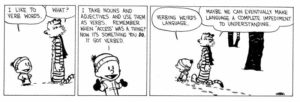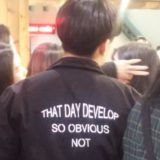Diving Into The Korean Grammar
 Having dipped my toe in the water by learning my first Korean words, I couldn’t resist just diving headfirst into the inviting waters of the Korean grammar. Much like my initial impressions of the Korean writing system and sound system, most of what I found in the grammar so far leaves me optimistic that even after a deeper dive I won’t encounter sharks. Korean word and sentence construction seem well-defined and regular, with none of the notorious elements that would scare off new learners. There are undoubtedly some parts of the grammar that will take some swimming around to really figure out, but my first few laps have been quite pleasant and refreshing.
Having dipped my toe in the water by learning my first Korean words, I couldn’t resist just diving headfirst into the inviting waters of the Korean grammar. Much like my initial impressions of the Korean writing system and sound system, most of what I found in the grammar so far leaves me optimistic that even after a deeper dive I won’t encounter sharks. Korean word and sentence construction seem well-defined and regular, with none of the notorious elements that would scare off new learners. There are undoubtedly some parts of the grammar that will take some swimming around to really figure out, but my first few laps have been quite pleasant and refreshing.
Here are the highlights of my first pass through the Korean grammar:
- No noun gender: After years of struggling to learn which German nouns are masculine, feminine, and neuter, in order to be able to use the correct article (der/die/das/dem/den/des) and adjective form, it is a huge relief to see that Korean does not have noun genders.
- No articles: Not only are there no noun genders, there aren’t even definite or indefinite articles.
- No noun cases: Some languages have large numbers of noun cases, where a single base noun, as well as the corresponding articles and adjectives, can take several different forms depending on the grammatical role. For example, German has 4 noun cases (nominative, accusative, genitive, and dative), so “the small man” can be “der kleine Mann” or “dem kleinen Mann” or “den kleinen Mann” or “des kleinen Mannes.” Russian has 6 cases (adding instrumental and prepositional to the German 4), Latin has 7 (adding vocative, ablative and locative), and Estonian has 14. Learning new nouns in these languages requires also learning the corresponding noun and adjective declensions. In Korean, each noun has a single form, and the grammatical role is marked with one of a small set of postfix particles.
- No plural noun forms: There is one word for each Korean noun, and it is used for both singular and plural contexts. So there is no need to learn rules for making nouns plural and no need to memorize irregular plural forms.
- Verb suffixes are regular and ordered: Korean is agglutinative, and full verb forms are created by “gluing” suffixes onto a verb stem. There are over 40 different suffixes for verb voice (passive, causative), honorifics, tense, aspect (completed vs.continuing action), and sentence type (declarative, interrogative, imperative). These suffixes can be combined in more than 400 different sequences. This sounds intimidating, but the gluing of the suffixes on the verb stem follows a pattern that is both regular and ordered: voice suffix is always first, then honorific, then tense, aspect, and type (with some suffixes optional). So the primary challenge is learning the 40+ suffixes and practicing the construction and parsing of full verb forms. And learning a lot of verb stems, of course, but that is a vocabulary challenge vs. a grammar challenge.
- No verb conjugation to enforce agreement with subject: One of the first challenges when learning many languages is learning to conjugate verbs to match the number, gender, and person of the subject, as well as the tense (present, past, future, etc.). English language learners spend countless hours learning how to conjugate English verbs like “to be” into its correct forms for each verb tense: I am, you are, he is, we were, he was, she will be, I have been, they might be. And Latin learners wrestle with conjugations like the famous Latin amare: amo, amas, amat, amamus, amatis, amant. For many languages you need to learn the dictionary form of the verb, plus all the conjugated forms of the verb, in each tense, for each person and number (I, you, he, we, etc.), for every verb. In Korean, there is just one single verb suffix used for all verbs in present tense, a single suffix for past tense, a single suffix for future, etc. Given this single suffix for a tense, all you need is to append it to the base form of any verb, regardless of the subject. The honorific suffixes add a small bit of complexity, but they also do not change based on the subject. As with any language, there are some irregular Korean verbs, but it appears to be a very manageable set.
 Verbing Korean nouns is easy: There is a suffix (하 / ha), which is the same as the verb stem for “to do”, and it will turn a noun into a verb. For example, adding 하 / ha to 행복 / haengbok (“happiness“) gives happiness + do, or the verb (stem) haengbokha- (“to be happy”). This is especially useful for verbing loan words: the borrowed English word date plus ha becomes the Korean verb (stem) teituha-, “to date (someone)”.
Verbing Korean nouns is easy: There is a suffix (하 / ha), which is the same as the verb stem for “to do”, and it will turn a noun into a verb. For example, adding 하 / ha to 행복 / haengbok (“happiness“) gives happiness + do, or the verb (stem) haengbokha- (“to be happy”). This is especially useful for verbing loan words: the borrowed English word date plus ha becomes the Korean verb (stem) teituha-, “to date (someone)”.- Consistent sentence structure: Korean sentences are, in general, subject-object-verb (SOV), vs. SVO for English (e.g., the equivalent of “He dinner ate” vs. “He ate dinner”). But English sentences can take many different structures, with base verbs and their auxiliary verbs interspersed with the subjects and objects. For example, compare the positions of verbs in “He ate dinner.” vs. “Is he able to eat dinner?” vs. “He wanted to be able to eat dinner.” vs. “Dinner was being eaten by him.” vs. “Would he have had dinner if he hadn’t already eaten?” In Korean the verb, with all its auxiliary components attached as suffixes, always comes at the end of the sentence, and other sentence elements are marked for grammatical role by particles.
- Pronouns and unnecessary phrases are usually omitted: In many languages pronouns are used as shorthand for a repeated subject. For example, you could say the two English sentences “My older brother is home. He was away.” In Korean the second sentence could just be “Was away” because the subject (my older brother) is understood. Similar elision is possible for pronouns and noun phrases in any context that is deemed understood, so that a question like “Do you have a ticket?” can be answered simply “Yes, have”. This makes Korean a pro-drop language. The tendency to omit pronouns is especially helpful to a Korean learner, because pronouns are closely tied to the complex honorific system and using the wrong pronoun in the wrong context can be extremely impolite.
Given the lack of intimidating topics in my initial pass through the grammar, my tentative plan of attack for the grammar will be:
- learn all the particles that mark grammatical function in sentences
- learn all the verb suffixes (grammatical and honorific) and practice building and parsing verbs
- learn the function words (conjunctions, wh- question words, key verbs, essential adverbs, times)
- practice reading and composing sentences
I fully expect to encounter some challenging elements in the grammar as I dive deeper, and I know the honorific system will require a lot of study and practice. While an integral part of the language, honorifics fall in the category of pragmatics and will be mostly important when I have learned enough to start talking to real people.
That leaves vocabulary, which by process of elimination promises to be the primary obstacle in my Couch to Korean challenge. Korean is a language isolate, which means I can’t draw on its language family for common vocabulary. A large percentage of Korean vocabulary comes from Chinese (similar to Latin-derived vocabulary in English), but that also won’t help me bootstrap the vocabulary since I haven’t studied Chinese.
I have been updating the Korean Resources page as I have found additional resources. For my initial grammar survey, I relied almost exclusively on three excellent, well-organized resources:
Share this Lexplorers post:










